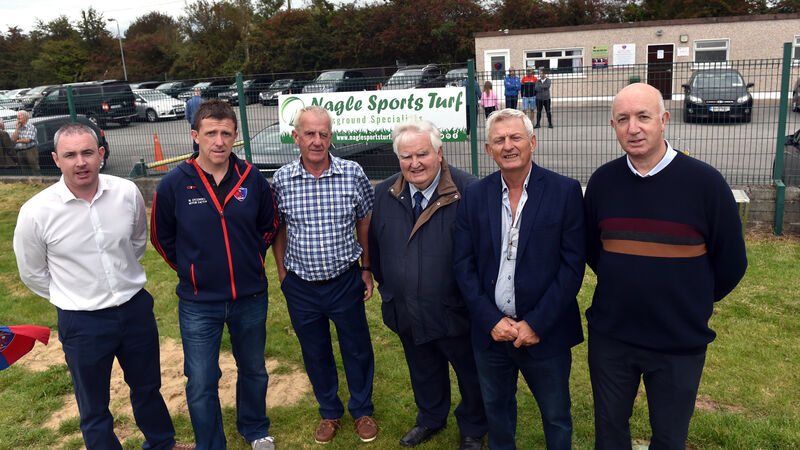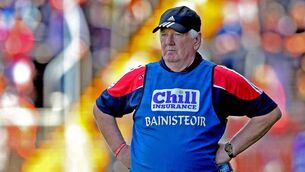Funding revamp draws mixed reaction from Cork clubs

Jamie Murphy, secretary; Pat O'Callaghan, assistant secretary; Dave Nagle, Sports Turf, sports grounds specialists, who relaid the pitch; Paddy Twomey, Tom Aherne, chairman; and Martin Bowen at the re-opening of the relaid pitch and opening of the hurling Wall at Erin's Own GAA club. Picture: Eddie O'Hare
The Cork County Board’s decision to revamp its funding mechanism, moving from the old county board draw to the new Rebel Bounty scheme, has drawn a mixed reaction from clubs in the county.
Under the new scheme clubs must sell a minimum number of €100 tickets (senior clubs 100 tickets, intermediate 70 and junior clubs 50) with the revenue going to the county board; clubs keep the money earned by tickets sold above those minimum numbers.
“We’re not in favour of it in the current economic and social climate,” said Donie Keane of Newcestown yesterday. “That’s for starters.
“It would need a lot of promotion, which the board is promising to do, but I don’t know if that will cut any ice. I can recall the late Jim Forbes coming down years ago about the county board draw and there might be nine or 10 at the meeting to hear him — and those would all be people who’d support and contribute anyway.”
As a senior club Newcestown would be expected to sell 100 tickets, but Keane pointed out that the demographics of the club’s catchment are not the same as other senior clubs in the county.
“We’re a senior club but we’re not a club on the scale of Bishopstown or Douglas, say. I’m looking out here at a country road and there are probably 10 houses in view.
“If we were playing in the county final tomorrow there might be two houses represented at that county final. People have come out from the city to live in our area but there’s no tie to the club — they’re going back in and out to the city to work.
“The demographics have changed totally. Not only is the catchment area small to begin with, but a lot of the people we have coming in don’t join the club or have no real ties to it.”
Keane also has other questions: “Where are Cairde Chorcai in all of this? We’re being told that funds raised in this draw are only for the running of the county board, but where have they (Chairde Chorcai) gone?
“And what is going to happen to clubs who decide not to become part of this new scheme? Are those clubs going to be punished in some way?”
Another club representative, who declined to be named, pointed out that the pandemic has had a huge economic effect on his club’s catchment area.
Identifying the six businesses in the club’s area, he said four were closed because of the pandemic, one was already involved in sponsoring the club, and the last business was a post office and small grocery.
Avril Geary of St Ita’s echoed that point: “Businesses in small communities all over Ireland are struggling, so that local club sponsorship which clubs depend on is already under pressure. There are already issues there when it comes to funding for clubs.
“We’ve seen that there are targets in the new scheme when it comes to clubs selling tickets, but clubs won’t get a cent even if they reach those targets — they have to exceed them to get any funding.
“On top of that, compared to the old draw there’ll be an extra hit if clubs don’t reach those targets. They’ll have to pay the county board the difference, for the unsold tickets, but they also won’t be getting the funding that would have been generated by selling the same number of tickets in the old draw.
“Certainly I think this is something that needed more consultation and detail, particularly for smaller clubs. We’re dealing with an unprecedented time for the country as a whole and to change the funding mechanism so much — I don’t think this is the right time for it.”
Geary added: “My club is against it, and our reasons are pretty straightforward — there’s a pandemic going on and we’re right in the middle of it, with all of the restrictions that that entails, particularly when it comes to getting out to raise funds.”
Yet there are clubs which will benefit from the new system as well — some of them may make more money than they did with the old draw.
Tom Aherne, chairman of Erin’s Own, points out that the Glounthaune club could realise as much as €25,000 from the draw.
“We always had a very good buy-in for the original county board draw,” says Aherne.
“We’d have as many as 300 people signed up, and that group was very loyal to the draw over the years.
“But I have to add that we put a lot of work into it, too. When the draw began in the first place we had a very hard-working committee, very good people who went out and pushed the draw and made sure the tickets got sold, in fairness.
“That’s the key to any draw or enterprise like this — you have to have people who are willing to work hard to make it succeed. We had people on that committee who might have had as many as 40 people signed up for the county board draw.
“As a result of that work, with the old draw we were doing very well, but we’d be hopeful that we’d retain the vast majority of those people in the new draw, which could yield as much as €25,000.”
Aherne acknowledges that not every club has the kind of populous hinterland Erin’s Own enjoys.
“Take a rural place like Dungourney, or a small place like Ballinacurra. It’s (the new draw) not going to suit places like those because you don’t have the population.
“And you need that population. I can well understand a small club like Ballinacurra mightn’t be as enthusiastic about this new draw, because it’d be much harder for them to sell tickets given the numbers down there.
“We’ve been lucky that people have been loyal to our draw and we’d be hoping they remain loyal, but it’s also worth pointing out that when the old draw was getting going, times were very different.
“That draw started off more or less in the time of the Celtic Tiger, or at least got stronger during that time, and the people who signed up with us at that time have stuck with us through thick and thin.
“Would we like to be starting from scratch signing people up now, in the middle of a pandemic? No.”










